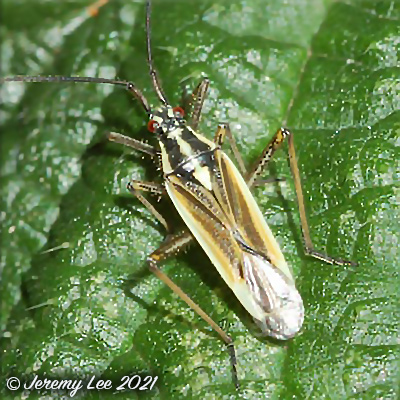
 |
|
Scientific Classifications explained » Amphibians » Ants » Aphids » Bees » Beetles » Birds » Bugs » Butterflies » Caterpillars » Damselflies » Dragonflies » Earwigs » Flies » Frog/Leafhoppers » Fungi » Galls » Grasshoppers » Harvestmen » Hoverflies » Lacewings » Ladybirds » Leaf Mines » Lichens » Mammals » Millipedes » Mosses » Moths » Sawflies » Slugs » Snails » Spiders » Trees & Shrubs » Wasps » Wild Flowers » Woodlice » Postboxes |
UK Nature > Bugs > Leptopterna dolabrata

Scientific Name: Leptopterna dolabrata Common Name: Meadow Plant Bug Leptopterna dolabrata is a member of the large and diverse insect family Miridae, which contains the plant bugs, leaf bugs, and grass bugs, and may also be known as capsid bugs. Leptopterna species are large and common grass bugs which often have reddish or orange-yellow forewings. They have a transverse furrow between the eyes and the legs and antennae are covered in long dark hairs. There are two very similar species, both of which are sexually dimorphic. Males are always macropterous (fully-winged) and females usually brachypterous (partly-winged). In the male, colour darkens with age, from black and yellow to black and orange-red. The length of the 2nd antennal segment is much greater than the 3rd and 4th combined. In the female the 2nd antennal segment is thinner than the base of the front tibia. A common and widespread bug throughout the UK, feeding on a variety of grasses. |
|

https://www.uknature.co.uk is a website dedicated to showing the immense diversity of UK nature and wildlife. Our vast range of habitats, from lowland arable to snow covered mountains, from storm-ravaged coastlines to peaceful inland freshwater lakes and rivers, from dry, sandy heaths to deciduous and coniferous forests, all these habitats contribute to the abundance of UK nature. We have wild birds in huge numbers either residing or visiting our shores (597 recorded species as at July 2013) and we must also not forget the humble back garden with its grass lawns, flower beds filled with nectar rich flowers, shrubs and trees, all designed to attract huge numbers of insects such as bees, moths, butterflies and hoverflies; and finally the small ponds which provide safe havens for frogs, toads, newts and even slow worms and grass snakes. www.uknature.co.uk is the showcase for my personal passion, photographing uknature in all its glory. I sincerely hope you all enjoy the fruits of my labours. This site and all images contained therein is © Jeremy Lee 2004 - 2025. All Rights Reserved. Site design by Jeremy Lee. Site development & IT Support by Stuart Lee. |